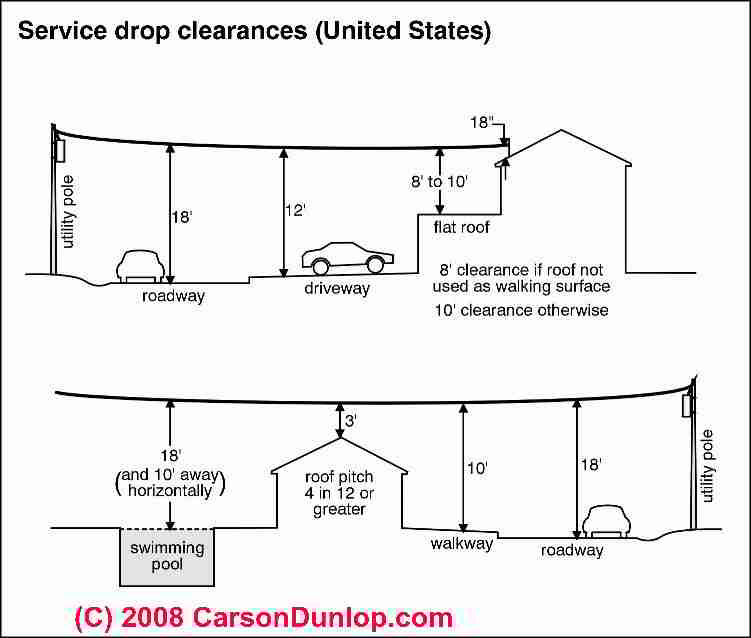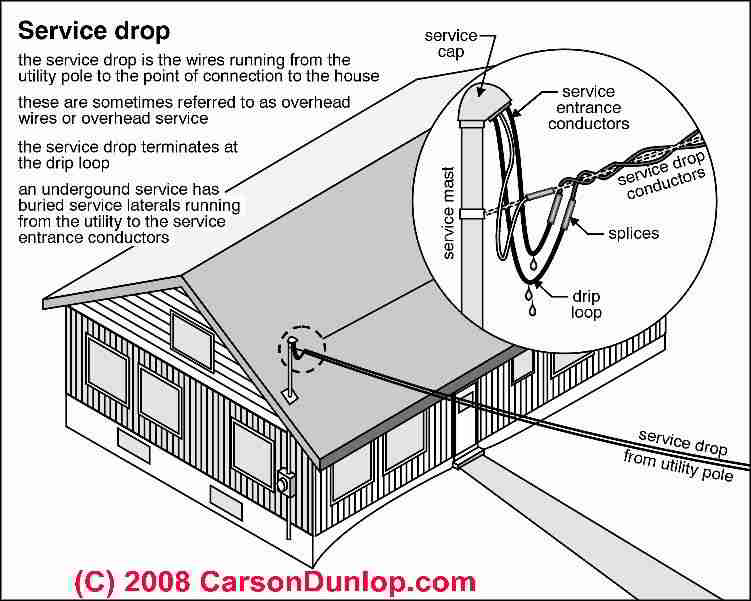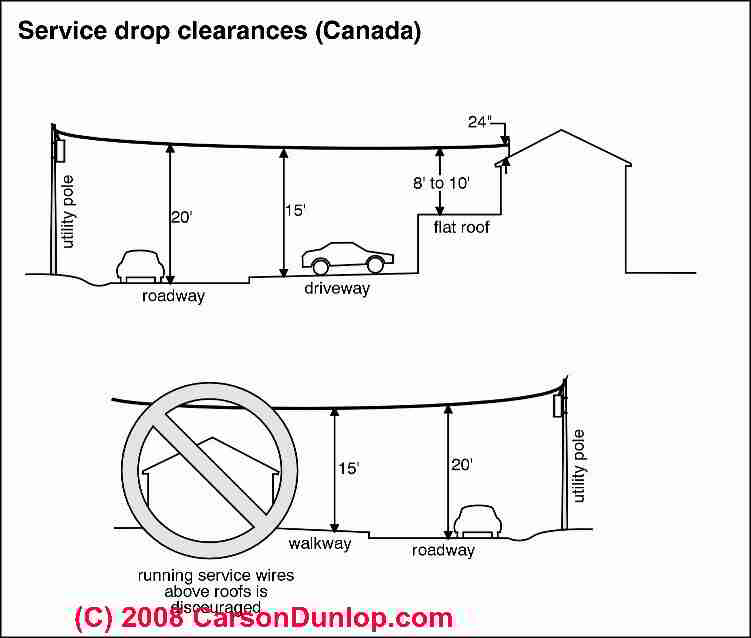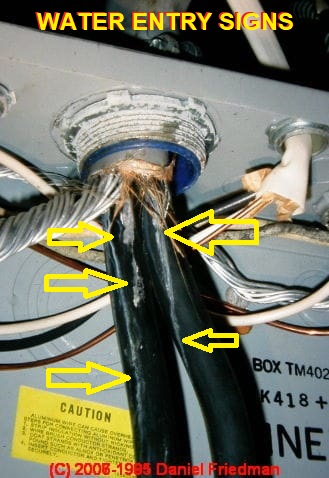 Electrical Service Drop
Electrical Service Drop
How to Inspect Residential Electrical Service Connections to a Building
- POST a QUESTION or COMMENT about inspecting the electrical service drop: clearances to overhead electrical wires, clearances from buildings, weather head security or leak defects.
Electrical service drop wire clearance distances and other defects.
How to inspect the electrical power service drop at a building.
InspectAPedia tolerates no conflicts of interest. We have no relationship with advertisers, products, or services discussed at this website.
- Daniel Friedman, Publisher/Editor/Author - See WHO ARE WE?
Inspecting the Electrical Service Drop or Service Lateral bringing electrical power to a building
- Electric Service Drop - overhead (may be underground)
- Check clearances of overhead service wires from rooftops, porches, obstructions - given in detail below on this page
- Look For: number of wires - 2/120V, 3/240V, 4/3-phase
- Look for: length of wires extending from the masthead for connection to the overhead service (at least 18" at time of installation).
- Look For: drip loop - present? Adequate? Details about drip loops at SECs are given below on this page.
- Look For: service cap - secure, facing down, un-damaged, present?
- Look For: service mast - secure, straight, flashed, present?
- Electric Service Lateral - underground (mostly not visible)
Sketches shown above are provided courtesy of Carson Dunlop Associates, a Toronto home inspection, education & report writing tool company [ carsondunlop.com ].
Electrical Service Drop Wire Clearances and Other Defects: U.S. & Canada
Our photo below illustrates inadequate or unsafe clearance of electrical wires over a building roof.
The required clearances for electrical service drop wiring
- electrical service wire clearance distance over roadway 18 ft. overhead
- electrical service wire clearance distance over roadway driveway 12 ft. overhead
- electrical service wire clearance distance over roadway flat roof 8-10 ft. overhead
- electrical service wire clearance distance over roadway roof 18" at mast, 3 ft. passing over
- electrical service wire clearance distance over roadway walkway 10 ft. overhead
- electrical service wire clearance distance over roadway swim pool 18 ft. vertical clearance, 10 ft. horizontal clearance
- electrical service wire clearance distance over roadway not over 30 ft. above grade
- electrical service wire clearance distance over roadway
- Overhead electrical conductors must be no less than 3 ft. from windows, fire escapes, doors - US NEC 225.19(D)(1)
- Overhead electrical conductor (such as service entry) must maintain clearance distance of at least 3 ft. from chimneys, signs, radio & TV Antennas and other non-building or non-bridge structures - US NEC 225.19(B)
- service wires shall not be damaged, frayed
Other electrical service drop wiring defects include
- electrical service wire obstructed by or contacting trees or vines
- electrical service wire not well-secured to house
- poorly connected to service entrance cable (SEC)
Overhead Electrical Service Drip Loop Requirements
 Definition: An overhead electrical service drip loop is a downwards bend in service entry wiring at the connection between masthead and ovehead service wires in order to assure that water on the wires does not run into the masthead that carries the electrical service down to a building electrical meter or panel.
Definition: An overhead electrical service drip loop is a downwards bend in service entry wiring at the connection between masthead and ovehead service wires in order to assure that water on the wires does not run into the masthead that carries the electrical service down to a building electrical meter or panel.
Our photo, courtesy of an inspectApedia reader, shows an overhead electrical service connection to the masthead (at left edge in our photo).
You can see that the installer included a drip loop in the wires, taking care that the bottom of the drip loop extends several inches below the openings in the masthead into which the descending electrical service entry wires enter to pass down the building wall into the electric meter.
Typical electrical service entry wiring specifications provided by your electrial supplier describe details of a proper and safe electrical service entry, including details of the overhead connection and drip loop using text such as the following:
Bottom of service head must be higher than loop wire at building.
Where it is necessary to place the house bracket or Wire holders at an elevation above the customer’s Service head, sufficient loop wire must be allowed to Connect the customer’s service wires to the loop Bottom of the drip loop.
Connectors on the covered Wire must be taped.
Wire holder (bracket) furnished and installed by Company.
Note that a quantitative measurement of overhead SEC drip loop depth below the masthead is not given. Rather this is a performance specification that simply says "...Bottom of service head must be higher than loop wire at building. "
The intent is clear: rainwater contacting the overhead service entry wires should not run down the wire and into the masthead.
What about that highest drip loop of the three wires in our photo above? Is that highest wire loop sufficiently below the bottom of the masthead?
Fortunately, for an electrical service that has been installed long enough to have been exposed to rainfall, it's easy for an electrician to verify that the SEC drip loop depth below the masthead is sufficient by inspecting the interior of the electric meter box. There she looks for signs of water tracking down the entering SEC cable or signs of water, moisture or corrosion inside of the meter box itself.
Above: yellow arrows mark signs of water stains on the service entry cable.
These marks suggest that water was running down the interior of an overhead service entry cable. Possible sources of such leaks include an inadequate drip loop at the mast head or frayed leaky SEC insulation or poor seals at the top of an electric meter box.
Electrical Service Entry / Service Drop Codes & Specifications
 Illustration adapted from City of Bloomington, MN Inspections Department. [Click to enlarge any image]
Illustration adapted from City of Bloomington, MN Inspections Department. [Click to enlarge any image]
- BGE GAS & ELECTRIC INSTALLATION SPECIFICATIONS [PDF] BGE, Baltimore Gas & Electric Co.
- BTU SERVICE ENTRANCE
REQUIREMENTS MANUAL [PDF] (2020) Bryan Texas Utilities, - retrieved 2022/06/17, original source: https://www.btutilities.com/wp-content/uploads/2020/05/BTU-Service-Entrance-Manual.pdf
Excerpt illustrating who is has responsibility for the electrical service entry:
The Customer’s installation of the service entrance equipment and conductors shall conform to Bryan Texas Utilities’ (“BTU”) Service Entrance Requirements Manual. BTU will inspect the service entrance to the first means of disconnect for conformity.
BTU does not, however, assume any duty of inspecting the Customer’s wiring, apparatus, devices, machinery or equipment.
It is particularly understood that the Customer assumes full responsibility for electric energy furnished to him/her at and past the point of delivery, described as being the point where the electric energy first leaves the line provided, owned and maintained by BTU and enters the line provided, owned and maintained by the Customer. - DTE, OVERHEAD ELECTRICAL SERVICE [PDF[ (2021) DTE Electric Company, retrieved 2022/06/17, original source: https://newlook.dteenergy.com/
- NSTAR GAS & ELECTRIC INSTALLATION REQUIREMENTS [PDF] NSTAR
The two documents above are referenced by GAS METER CODES & CLEARANCE DISTANCES - MOBILE HOME ELECTRICAL POLE SETUP (GLPS, Greenville TN) [PDF] includes specifications for electrical service masthead, pole, drip loops, etc. for manufactured homes, trailers, doublewides.
Excerpt:
Weatherhead:
The weather head must be within the top 2 feet of the pole and have at least 18 inches of wire extending through the weatherhead for the [electric utility company] to connect to. - OPPD, OVERHEAD ELECTRICAL SERVICES - RESIDENTIAL & GENERAL SERVICE [PDF] (2016) OPPD, Omaha Public Power District, Website: https://www.oppd.com/, retrieved 2022/06/17 original source: https://www.oppd.com/media/21805/Meter-Manual-Chapter-6-Overhead-Services.pdf
Excerpts:
OPPD’s service drop will terminate at the first point of contact on the building or structure supporting the metering equipment. The attachment point, riser conductors, conduits and fittings for both Residential and General Service customers are the customer’s responsibility.
Current code requires 10 feet minimum above grade to the bottom of the drip loop.
Without exception, no parts of swimming pools, wading pools, hot tubs, etc. shall be placed under existing service-drop conductors or any other open overhead wiring. Nor shall such wiring be installed above the following:
A: Swimming pool, wading pool, hot tubs, and the area extending 10 feet horizontally from the inside of the walls of the pool or tub.
B. Diving structured
C. Observation stands, towers, or platforms - U.S. NEC Article 230, Electrical Services - Article 230, consists of seven parts and describes the installation requirements for service conductors and equipment.
Parts II, III, and IV address conductors. For now, we'll focus on the requirements for equipment, which are covered in Parts I, V, VI, and VII. The titles of these are General, Service Equipment, Disconnecting Means, and Overcurrent Protection, respectively.
Electrical Vocabulary & Terms for Residential Electrical Inspectors
Moved to
DEFINITIONS of ELECTRICAL TERMS
...
Reader Comments, Questions & Answers About The Article Above
Below you will find questions and answers previously posted on this page at its page bottom reader comment box.
Reader Q&A - also see RECOMMENDED ARTICLES & FAQs
Flexible conduit OK for service entry wiring?
Hi All,
Are electrical drop boxes considered hard wired installations, or does NFPA/OSHA considered them flexible cables? Are there specific regulations for drops outside of clearance standards?, or do they fall under standard wiring standards ? - On 2020-07-10 by Anonymous
Reply by (mod) - OK but may need to be liquid-tight
Anon,
Thank you for the question. I think you're asking about whether or not it's ok to use metallic flexible-cable for service entry cable (US NEC Article 338)
that is, you're not asking about using flexible metal conduit,
You would not use flexible cable in a water-exposed location - not water tight. But it's not prohibited in general.
Here's a pertinent US NEC excerpt:
NEC 230.43 Wiring Methods for 600 Volts, Nominal, or Less.
Service-entrance conductors shall be installed in accordance with the applicable requirements of this Code covering the type of wiring method used and shall be limited to the following methods:
(15) Flexible metal conduit not over 1.8 m (6 ft) long or liquidtight flexible metal conduit not over 1.8 m (6 ft) long between raceways, or between raceway and service equipment, with equipment bonding jumper routed with the flexible metal conduit or the liquid-tight flexible metal conduit according to the provisions of 250.102(A), (B), (C), and (E)
Note: for an electrical service entry cable your cable will be marked SE or USE
Roofer won't work on roof because of electrical wires
The roofing company said it could not deliver and install shingles because our neighborhood service drop is connected to our two story house. How can we replace our roof? - On 2020-07-08 by Sally
Reply by (mod) -
Sally
Well we can't fault the roofer from being careful not to electrocute her workers,
But the problem is simple to resolve:
Arrange or have an electrician arrange that the electrical service drop to your house be disconnected at the utility pole by your electric company.
You'll either have to do without electricity while the area of roof in danger of touching the service entry wires is re-done or, if multiple days of no-power are needed you might arrange for temporary restoration or a backup generator with a transfer switch to be sure no power is fed back out of the house to the roof service entry wiring.Followup by Sally
Thanks for the reply. It wouldn’t be that much of a problem if we were the only ones who would be without power, but supposedly it’s 4 other neighbors who may have a problem doing without power for too long. I think the power company needs to upgrade.
Reply by (mod) -
Unkess there's something odd and not yet mentioned, its entirely possible and usual to drop power to just on one building.
At what height do underground electrical service wires penetrate the building wall to get to the panel?
I am putting a new electrical service to my detached garage through a buried conduit.
At what height do I penetrate the exterior wall to continue the conduit to the sub panel?
The conduit will exit the ground and will be surface mounted to the penetration as the garage is on a concrete slab with no way to continue the trench under the foundation without a jackhammer. - On 2018-12-31 by Rick
On 2019-01-01 - by (mod) -
Rick
I have not found a specification requiring a particular height for the wall penetration for your conduit bringing electrical wiring from underground up through conduit through the foundation wall and into the structure interior.
Remember that the conduit needs to be weatherproof including the fitting used to give access to the 90 degree angle to make the turn to penetrate the wall.
Even though that fitting is required to be weatherproof , in my opinion I would prefer to make the height of such a penetration high enough to be well above any likely standing water, puddles, Etc.
Electrical mast just 1 foot above roof gutter
I have added on to a house with overhead service. The addition makes the mast less than 1 foot near the new gutter of the roof. Is there not a required distance the mast should be from the roof gutter/valley? - On 2018-04-12 by Willie E
Reply by (mod) -
As the guidelines include 8-10 ft above any flat roof and no less than 24" above a gable roof at the mast head, your cables are too close to the gutters.
Service drop wires touch both pole and guy-wire.
Hi. The electric service drop to my house was so tight it pulled the weather head toward the pole and warped the roof shingles. I complained and they loosened the drop. The service is a terminal pole.
The drop also touches the guy wire at the top of the pole. The fix was to place a yellow protection cover over the guy wire. I asked the utility company about it and they said unless it starts to arc, I shouldn't worry about it. I have had 4 lightning strikes this year. Any thoughts or help? Thanks much! - On 2017-08-09 by mullen
Reply:
Your electrical company is responsible for both meeting code and safety; if you're still nervous about this "fix" - as am I - you might try first a friendly conversation with the company's service manager and after that a notice in writing of your concerns. Often, putting something in writing is more-effective.
In my opinion, service entry wires too close to or touching a utility pole guy wire could indeed be a lethal shock hazard.
Equation to figure the sag in an overhead service spanning 200' with #2 quadplex
Is there an equation to figure for sag in an overhead service spanning 200' with #2 quadplex - On 2017-05-04 by DC -
Reply by (mod) -
Sure DC in several engineering texts and also in college and university material.
The standard equation isT2 (T - K + aEa (q2-q1)) = W2 L2 aE / 24 x q2
T = Tension at temperature q2 (kg)
K= Constant
a = Area of conductor/Earth wire (mm2)
E = Modulus of Elasticity kg/mm2
a = Linear Coeft. of expansion (per degree celcius)
W = weight of conductor (kg/m)
L = Equivalent span (m)
q = Wind load factor = P2 + W2 / W2 = 1 (At no wind condition)
q1 = Initial condition temperature- Source: Sag and tension calculations for conductor earth wire are done for the river crossing by following steps - Uttar Pradesh Power Transmission, Corporation, Limited, Web: https://upptcl.org/, retrieved 2024/08/30 Local copy on file as Sag and Tension Calculations For Conductor_Earth Wire For River Crossing _ Welcome to Uttar Pradesh Power Transmission Corporation Limited, Government of Uttar Pradesh, India_.pdf
Why is my electric meter not working? Electrician says service drop needs replacement
Would you please tell me what are the reasons why the electric meter is not working, as per my electrician the service drop is rusted and need to replace. Is this correct? - On 2017-04-10 by Bong
Reply by (mod) -
Watch out: I suggest calling your electric utility company immediately to ask them to look at your electric meter since what you describe sounds unsafe and possibly a fatal shock or fire hazard
...
Continue reading at ELECTRICAL SERVICE ENTRY WIRING or select a topic from the closely-related articles below, or see the complete ARTICLE INDEX.
Or see these
Recommended Articles
- AMPS VOLTS DETERMINATION - home
- CORROSION & MOISTURE SOURCES in PANELS
- GAS METER CODES & CLEARANCE DISTANCES - service entrance specifications for gas often in same document as for electricity
- SERVICE ENTRY WIRING & AMPACITY - home
- VISUALLY DETERMINE AMPS & VOLTS
Suggested citation for this web page
ELECTRICAL SERVICE DROP at InspectApedia.com - online encyclopedia of building & environmental inspection, testing, diagnosis, repair, & problem prevention advice.
Or see this
INDEX to RELATED ARTICLES: ARTICLE INDEX to ELECTRICAL INSPECTION & TESTING
Or use the SEARCH BOX found below to Ask a Question or Search InspectApedia
Ask a Question or Search InspectApedia
Questions & answers or comments about inspecting the electrical service drop: clearances to overhead electrical wires, clearances from buildings, weather head security or leak defects. .
Try the search box just below, or if you prefer, post a question or comment in the Comments box below and we will respond promptly.
Search the InspectApedia website
Note: appearance of your Comment below may be delayed: if your comment contains an image, photograph, web link, or text that looks to the software as if it might be a web link, your posting will appear after it has been approved by a moderator. Apologies for the delay.
Only one image can be added per comment but you can post as many comments, and therefore images, as you like.
You will not receive a notification when a response to your question has been posted.
Please bookmark this page to make it easy for you to check back for our response.
IF above you see "Comment Form is loading comments..." then COMMENT BOX - countable.ca / bawkbox.com IS NOT WORKING.
In any case you are welcome to send an email directly to us at InspectApedia.com at editor@inspectApedia.com
We'll reply to you directly. Please help us help you by noting, in your email, the URL of the InspectApedia page where you wanted to comment.
Citations & References
In addition to any citations in the article above, a full list is available on request.
- Ampacity of an Electrical Service: How to determine the electrical service size or ampacity entering a building
- "Electrical System Inspection Basics," Richard C. Wolcott, ASHI 8th Annual Education Conference, Boston 1985.
- "Simplified Electrical Wiring," Sears, Roebuck and Co., 15705 (F5428) Rev. 4-77 1977 [Lots of sketches of older-type service panels.]
- "How to plan and install electric wiring for homes, farms, garages, shops," Montgomery Ward Co., 83-850.
- "Simplified Electrical Wiring," Sears, Roebuck and Co., 15705 (F5428) Rev. 4-77 1977 [Lots of sketches of older-type service panels.]
- "Home Wiring Inspection," Roswell W. Ard, Rodale's New Shelter, July/August, 1985 p. 35-40.
- "Evaluating Wiring in Older Minnesota Homes," Agricultural Extension Service, University of Minnesota, St. Paul, Minnesota 55108.
- "Basic Housing Inspection," US DHEW, S352.75 U48, p.144, out of print, but is available in most state libraries.
- In addition to citations & references found in this article, see the research citations given at the end of the related articles found at our suggested
CONTINUE READING or RECOMMENDED ARTICLES.
- Carson, Dunlop & Associates Ltd., 120 Carlton Street Suite 407, Toronto ON M5A 4K2. Tel: (416) 964-9415 1-800-268-7070 Email: info@carsondunlop.com. Alan Carson is a past president of ASHI, the American Society of Home Inspectors.
Thanks to Alan Carson and Bob Dunlop, for permission for InspectAPedia to use text excerpts from The HOME REFERENCE BOOK - the Encyclopedia of Homes and to use illustrations from The ILLUSTRATED HOME .
Carson Dunlop Associates provides extensive home inspection education and report writing material. In gratitude we provide links to tsome Carson Dunlop Associates products and services.





